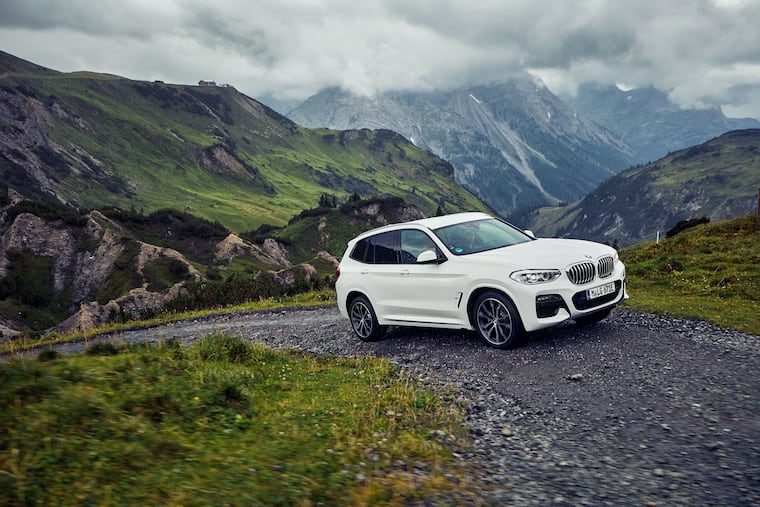BMW gives the X3 an E, and whee!
For 2020, BMW adds a plug-in hybrid to the X3. The combined horsepower totals 288, and 60 mph comes in 5.9 seconds, so it's not just for fuel savings.

2020 BMW X3 xDrive30E: Fun and fuel sipping?
Price: $65,020 as tested. Driver Assistance Package and Plus Package added $1,900 total. More mentioned below.
Conventional wisdom: Edmunds.com likes the “smooth ride and comfortable seats, wide variety of standard and optional features for personalization, roomy interior for both front and rear passengers” but not the “limited real-world EV range, lower fuel economy than the gas-only X3, questionable value proposition of the plug-in hybrid.”
Marketer’s pitch: “Discover the freedom of a versatile plug-in hybrid.”
Reality: A nice blend of both worlds — at least when packaged right.
What’s New: The XDrive30E version of BMW’s X3 features a plug-in hybrid that’s all new for 2020.
Up to speed: When I last wrote about the 2018 X3, I complained that it didn’t have much low-speed oomph when getting started. The problem seems well cured this time around, but that might be thanks to the electric motor and 12 kWh battery attached to the 2.0-liter four.
Total power from the unit is 288 horsepower, and 0-60 takes just 5.9 seconds, according to BM. Again, like most luxury hybrids, try to delete the putt putt Prius image from your mind — the electric motor adds 107 of those horses. Exceeding posted speeds is far too easy, and I found myself heading to 70 without even meaning to.
BMW advertises 18 miles of electric-only range from the battery, and that figure seemed not too worn down by Mr. Driver’s Seat’s heavy foot. (I guess BMW knows its customers.)
Shifty: The X3 tested also got the standard BMW ShiftTronic lever, which offers shiftability or automatic mode. Selecting your own gears from the 8-speed gearbox is rewarding and easy, and the shifter feel is just right. Automatic mode also works well.
On the curves: The MSport package ($5,000) and Dynamic Handling Package ($1,400) combine to return the X3 to the days of joy that I recall from the early 2010s, when the midsize SUV was a little smaller and easier to handle. It felt a little bulky in its 2018 incarnation, but this 2020 model felt crisp and direct. I spent far too much time frightening the Lovely Mrs. Passenger Seat on country roads, getting a feel for the curves. (Not only is she suffering with me at home all day during quarantine, but then I drag her along on tests to tell her her opin— I mean, to get her opinion.)
Sport and Comfort modes each offer delightful times. I’m not much for “Eco.” If I wanted to save gas, I could go lighter on the pedal by choice, and, oh, also not buy a BMW.
The X3 also plays a more user-friendly version of the X5, so if you don’t need all that bulk, look for something more manageable.
Driver’s Seat: BMW hasn’t messed around with gauges and the rest of the cockpit too much, and I continue to shout, “You go, girl.” Everything remains visible, clean, and easy to locate.
The cognac vernasca leather interior (part of the $4,500 Executive Package, which also heats the seats and steering wheel, adds sunroof, surround view and more) is also comfortable and attractive, as is the fineline cove matte finish wood trim (also part of the package), although the seat keeps a little too much lumbar support for me even when I turn it all the way down.
Friends and stuff: Rear seat space has also opened up in this year’s model. Headroom and legroom remain roomy, and now foot room is also expanded. The rear seat is a comfortable perch as well. It’s a little flat, but that makes the middle seat a little more doable. Even legroom in the center is not too bad.
Cargo space is 59.4 cubic feet with the rear seat down, and 27.2 with it up.
Play some tunes: The stereo interface follows BMW standard as well, with a dial and buttons controlling functions and a volume knob on the dashboard. Operation is slick and simple, with a list of Sirius channels or iPod songs set as the default menu, and a simple scroll through names getting you to exactly what you want.
Sound from the Harman Kardon system ($875) is very good, probably an A, after some equalizer fiddling.
Keeping warm and cool: Dials control the cabin temperature and buttons control everything else, easy peasy.
Looking around: Highway driving was pleasant, but the BMW is a little tough to see out of, especially for keeping track of other lanes. Sideview mirrors are smaller than I’d like.
Fuel economy: I averaged around 25 mpg in a week of not much driving and keeping this SUV charged up. To speak to Edmunds' criticism, that’s 2 mpg better than the 2018 X3 I tested. The X3e drinks only the best.
Where it’s built: Spartanburg, South Carolina
How it’s built: The X3 gets a 3 out of 5 for reliability from Consumer Reports.
In the end: If you’re looking for a hybrid to simply save fuel, the X3 xDrive30e may not be the right choice. But it performed so much better than the 2018 X3 I tested that it’s worth checking out. Meantime, write to BMW and tell them to send me all the possible vehicle combinations so Mr. Driver’s Seat can better serve you, the reader.